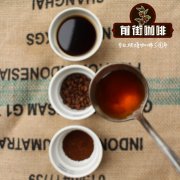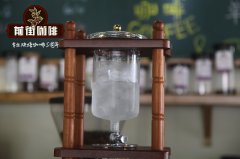How about Indian monsoon coffee? The source of monsoon coffee? What is monsoon treatment method monsooni

Professional coffee knowledge exchange more coffee bean information please follow the coffee workshop (Wechat official account cafe_style)
Qianjie Coffee brief introduction of monsoon treatment monsooning:
There are several reasons why Indian coffee is popular with coffee lovers, but the most important is a process used on coffee beans, often referred to as the "monsooning" process.
Monsoon coffee (rainy season Malaba) is a unique coffee from southern India using a typical air-drying process, specially stored in an open warehouse and exposed to the monsoon to increase viscosity and reduce acidity.
But when it comes to wind-stained coffee, it's a new flavor created inadvertently. In the 17th and 18th centuries, India shipped coffee beans to Europe by sailboat, which took six months. The raw beans were placed on the bottom of the barn and absorbed the moisture and salty taste of the sea. The raw beans arrived in Europe and had deteriorated. The color changed from dark green to the yellowish brown of rice. The acidity of the coffee almost disappeared, but it unexpectedly developed a strong nutty and cereal flavor. It tasted full, with a bit of black rice tea flavor. The original coffee shipped to Europe took more than half of the time to become "transformed" and lost its original flavor, so exporters thought of the salty and wet environment blown by the Indian ocean along the coast of Malaba in southwestern India every year from late May to September. After several experiments, it was made similar to the old golden coffee without acid, so it was named "monsoon coffee", commonly known as wind-stained coffee. For hundreds of years, it has been widely used by European coffee manufacturers to prepare mixed coffee beans, which can increase the consistency and tea feel.
Monsoon coffee is stored in a special warehouse until the monsoon arrives, and the ventilation structure is designed to allow the moist monsoon to circulate between the coffee beans, so that its volume expands and shows a mellow but strong mildew smell. The monsoon process is labor-intensive: coffee is spread out in special ventilated warehouses and raked or turned by hand to allow coffee beans to absorb moisture in the moist wind. The whole process takes 12 to 16 months, in which the coffee beans expand to twice their original volume and have a dull golden yellow. Then the coffee beans that are not fully inflated are picked out with extra processing, and the rest of the coffee is to be exported.
During the voyage of Malaba Malabar coffee beans in India, at the bottom of the cabin, they come into contact with the moisture and salty taste of the sea surface and ripen into golden, acid-free, nutty-grain coffee. Later, after experiments, monsoon treatment was developed to reproduce this flavor:
1. put the stored beans in the factory facing west, the sun-dried coffee beans are laid flat in the field, and the windows are all open in order to catch the salty and wet monsoon blowing from the southwest.
2, coffee beans can not be too full, because coffee bags are too dense to lead to airtight and mildew, but also from time to time to pour out coffee beans to replace sacks so as not to breed mold, which is time-consuming and labor-consuming.
3. This period of time is about 12 to 16 weeks, and after maturity, it has to be fumigated to drive away weevil.
4. Sift the beans manually and pick out the failed beans that have not turned golden.
5. After at least six months to a year of monsoon blowing, the quality and quantity of beans have changed significantly. The volume of coffee beans will swell by one to two times, the weight and density will decrease, and the moisture content will be about 13%.
Because the coffee beans have been exposed to the moist monsoon for a long time, the acidity of the coffee itself has been greatly reduced, the taste is very special, and it will be a little salty. Rich aromas of caramel, raisins and herbs, with a raspberry finish and a taste of black rice tea.
Qianjie Coffee is recommended to be made by hand:
Recommended cooking method: hand flushing
Filter cup: Hario V60
Water temperature: 90 ℃
Powder / water ratio: 1:15
Degree of grinding: BG 5R (pass rate of Chinese standard No. 20 screen 58%)
Cooking method: 32 grams of water steaming for 32 seconds, injection to 126 grams, and so on when the water level is about to expose the powder bed, continue to inject water to 228 grams, when the water level is about to expose the powder bed, remove the filter cup, (steaming starts) the extraction time is one minute and 50 seconds.
Important Notice :
前街咖啡 FrontStreet Coffee has moved to new addredd:
FrontStreet Coffee Address: 315,Donghua East Road,GuangZhou
Tel:020 38364473
- Prev

Front Street Coffee is the main feature of the third wave of coffee
Professional coffee knowledge exchange More coffee bean information Please pay attention to the main characteristics of the third wave coffee workshop (Weixin Official Accounts cafe_style) Improve coffee quality, more direct trade, more emphasis on sustainability, lighter roasting, innovative brewing methods These are the essence of the third wave coffee. We pursue sweetness, complexity and uniqueness in the brewing process. we are
- Next

The history of espresso the history of espresso
Professional coffee knowledge exchange more coffee bean information Please follow the history of espresso in the coffee workshop (Wechat official account cafe_style) for more than 1000 years, coffee has been an important part of our world history, and with its popularity around the world, its rituals have been accepted in different cultures. For generations, many countries have enjoyed unique varieties of coffee, but
Related
- Beginners will see the "Coffee pull flower" guide!
- What is the difference between ice blog purified milk and ordinary milk coffee?
- Why is the Philippines the largest producer of crops in Liberia?
- For coffee extraction, should the fine powder be retained?
- How does extracted espresso fill pressed powder? How much strength does it take to press the powder?
- How to make jasmine cold extract coffee? Is the jasmine + latte good?
- Will this little toy really make the coffee taste better? How does Lily Drip affect coffee extraction?
- Will the action of slapping the filter cup also affect coffee extraction?
- What's the difference between powder-to-water ratio and powder-to-liquid ratio?
- What is the Ethiopian local species? What does it have to do with Heirloom native species?

